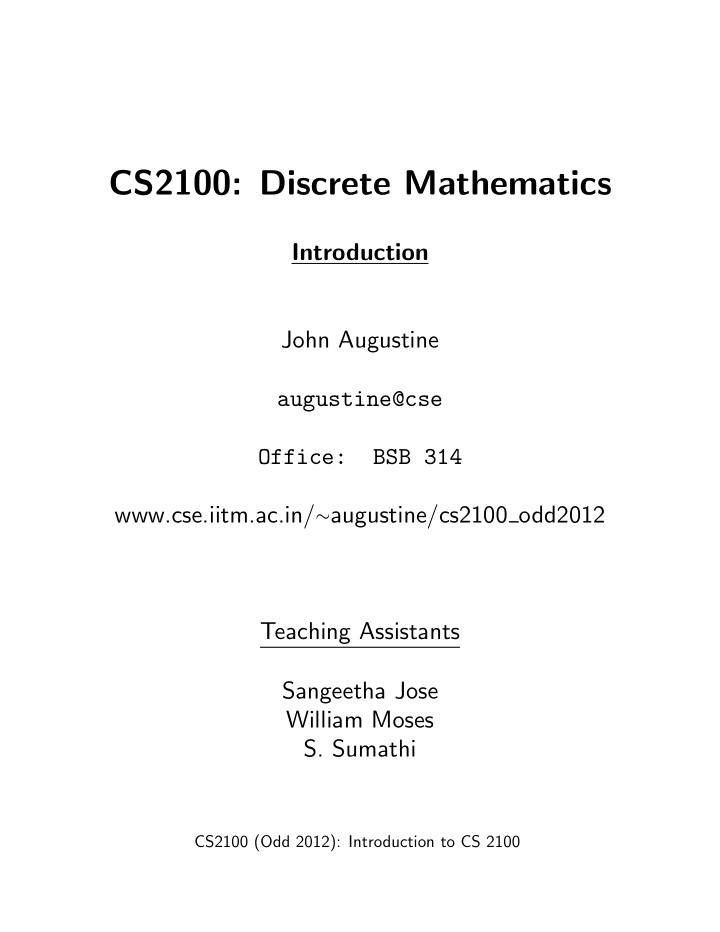



CS2100: Discrete Mathematics Introduction John Augustine augustine@cse Office: BSB 314 www.cse.iitm.ac.in/ ∼ augustine/cs2100 odd2012 Teaching Assistants Sangeetha Jose William Moses S. Sumathi CS2100 (Odd 2012): Introduction to CS 2100
What is Discrete Mathematics? It is NOT continuous mathematics. � I like to think of it as the study of puzzles. � Discrete mathematics deals with discrete structures that lack continuity. CS2100 (Odd 2012): Introduction to CS 2100 1
Some examples will help us differentiate between continuous and discrete mathematics. How would you classify the following? • A ball falling down moves smoothly or continuously down. • Two balls are to be placed in two distinct bins among a total of n bins. How many ways can this be achieved? • The science of planetary motion. • The study of pollutants in water. • You have a list of people and some idea about who are friends and who are not in talking terms. You want to seat them in a banquet so that everybody is happy. • How does the frequency vary when you pluck a guitar string and slowly tighten the tuning knob? • In a piano, you play a chord by simultaneously playing two or more different notes. How many three-note chords are possible in an 10-key piano? • How does the computer store the number π ? CS2100 (Odd 2012): Introduction to CS 2100 2
Finding your way through a maze A B How many paths are there from A to B ? In general, given a road network, we can ask: • Is there a path from some point A to another point B ? • If it exists, report a path. • What is the shortest path? • How many paths are there? • What is the longest path? CS2100 (Odd 2012): Introduction to CS 2100 3
Course Syllabus The material we cover will include: Mathematical Reasoning. Prepositions; negation, disjunction and conjunction; implication and equivalence; truth tables; predicates; quantifiers; natural deduction; rules of inference; methods of proofs; use in program proving; resolution principles; application to PROLOG. Set Theory. Paradoxes in set theory; inductive definition of sets and proof by induction; Peono postulates; relations, representation of relations by graphs; properties of relations; equivalence relations and partitions; partial orderings; posets, linear and well-ordered sets. Graph Theory. Elements of graph theory, Euler graph, Hamiltonian path, trees, tree traversals, spanning trees. CS2100 (Odd 2012): Introduction to CS 2100 4
Functions. Mappings; injections and surjections; composition of functions, special functions, pigeonhole principle, recursive function theory. Abstract Algebra. Definition and elementary properties of groups, semigroups, monoids, rings, fields, vector spaces and lattices. Some more set theory. Finite and infinite sets; cardinality, countable and uncountable sets. Furthermore, I hope to cover some additional topics in combinatorics and probability theory. CS2100 (Odd 2012): Introduction to CS 2100 5
Connections to Other Computer Science Courses Digital Logic Design. Theory of Computation. Data Structures and Algorithms. Operating Systems. Database Systems. Computer Networks. . . . CS2100 (Odd 2012): Introduction to CS 2100 6
Recommend
More recommend